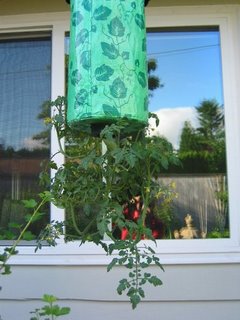
Tomatoes are not as easily grown in the Pacific Northwest as in other parts of the country - in the SPring and Fall, the days are too short, and during the summer, the nights are too cool. Even so, after 4 years of trying, last year there were lots of tomatoes - big ones, cherry tomatoes, red, and yellow. The "secret" seems to be a combination of factors: right variety, right location, right soil treatment, right grooming (some would say pruning).
For variety, my luck has been best with hybrids such as Better Boy, Lemon Boy, and Celebrity. Heritage varieties, like Brandywine and Cherokee do have great flavor, but it's a lot of effort to get just a couple of tomatoes. Of the Cherries, Sweet100 has been very productive. This year, Lemon Boy and Better Boy both have small tomatoes the size of small plums. I am growing Sweet100 again, which has bebe sized fruit now. New varieties for this year include Sungold (also with bebe sized fruits), Sugar Snack, Tomande, and Sweet Baby Girl. Plus a few more. So, a few proven performers, a few to experiment on, and 2 heritage varieties (Cherokee and Yellow Brandywine).
For location, some are in a bed on the south side of the house. This is starting to be shaded by grape vines, so may not be as productive this year. Others are in a free-standing bed, and get full sun all day.
For soil treatment, the beds were treated with many bags of leaves last fall, turned into the soil. They were given kitchen scraps dug into the soil for compost. In the Spring, the soil was covered with a layer of leaf compost. When it became warmer, they were mulched with bark dust.
For grooming, they are all being trained to stakes, and each sucker pruned off after the first leaf ("
missouri pruning")
None of this is scientific. Maybe this year will be productive, and maybe it wont - but it's starting to look promising.

Of course, there are as many ways to grow tomatoes as there are gardeners. Even upside down - this one is Sweet100. A close look shows lots of blossoms and a few bebe sized tomatoes on this plant too. This one is in full sun on the south side of the house.



 Lemonboy was productive last year - the first large tomato that I have been able to grow here. This plant has the most and largest so far - about plum size - but they will probably continue to grow until they ripen. My guess is that we will get fresh tomatoes in late July.
Lemonboy was productive last year - the first large tomato that I have been able to grow here. This plant has the most and largest so far - about plum size - but they will probably continue to grow until they ripen. My guess is that we will get fresh tomatoes in late July.





